Hours after Brazilian President Jair Bolsonaro painted a rosy picture of his administration’s environmental record during a United Nations speech, Greenpeace and other environmental groups released a set of photos showing continued deforestation and fires in Earth’s largest rainforest.
Speaking to the UN General Assembly in New York on Tuesday, Brazilian President Jair Bolsonaro cited a 32 percent reduction in deforestation in the month of August relative to a year ago, the country’s near decade-old Forest Code, and lands set aside as Indigenous territories — which he’s fought to undermine and dismantle — as evidence of Brazil’s contributions toward mitigating climate change.
“Which other country in the world has a policy of environmental protection like ours?” asked Bolsonaro, during his 12-minute speech, where he also acknowledged the country was facing “great environmental challenges.
But activists pushed back on Bolsonaro’s statement, noting rising deforestation in the Amazon and his administration’s rollback of environmental laws and law enforcement, and publishing dramatic images captured in two Amazon states between September 14 and 17.
“While Bolsonaro was en route to New York, we flew over the Amazon to record the reality of the destruction of the largest tropical rainforest in the world: illegal deforestation and burning. The images don’t lie, but the same cannot be said of President Bolsonaro in his speech at the UN,” said Stela Herschmann, Climate Policy Specialist at the Climate Observatory, in a press release.
“What we saw from above was the forest covered in smoke and unchecked devastation on the ground. Setting fire to the forest is part of the deforestation cycle, which includes the initial removal of the most valuable trees, a financial benefit for those who invest in land grabbing,” said Romulo Batista, a spokesperson for the Greenpeace Brazil Amazon Campaign. “And it is a crime, as set forth in the Executive Order No. 10,735, of June 28, 2021, which bans the use of fire in agricultural and forestry activities in Brazil.”
Brazil does have some of the strongest forest protection laws on the books among major tropical forest nations, but enforcement has been lax, especially under Bolsonaro, when the deforestation rate in the Amazon has climbed to the highest level since 2008.
Bolsonaro’s reference to one month of deforestation data doesn’t reflect the trend of rising deforestation that he’s presided over since taking office in January 2019. According to data from both the Brazilian government and Imazon, an NGO that independently tracks forest destruction, deforestation is distinctly higher now than at any time under Brazil’s two previous presidents, Dilma Rousseff and Michel Temer. Looking at just the past 12 months, INPE’s preliminary data suggests a slight drop in deforestation relative to last year, when forest clearing in the Amazon topped 11,000 square kilometers, an area the size of Jamaica. But in contrast, Imazon’s data shows deforestation roaring ahead, well outpacing last year’s rate.
Bolsonaro typically speaks about reducing “illegal deforestation,” but as Batista notes, the administration has been reducing budgets for law enforcement, forgiving fines for illegal deforestation, and rolling back laws restricting forest clearing.
“Legalisation of illegal deforestation has accelerated since President Bolsonaro took office,” wrote Philip M. Fearnside, an Amazon specialist at the National Institute for Research in Amazonia (INPA) in Manaus in a May 2021 commentary published on Mongabay. “A first step in this process is the legalization of illegal land claims, after which past deforestation on the new ‘properties’ can be legalised and future deforestation can be allowed through the existing permitting system. Legalising illegal land claims in Brazilian Amazonia has been shown to stimulate deforestation.”
“Proposals for other forms of legalising deforestation are also in the works, including allowing ranchers and soy planters to deforest legally within Indigenous lands.”
Both activists and scientists are concerned that ongoing deforestation in the Amazon, combined with the worsening effects of climate change, could tip the rainforest ecosystem toward a drier savanna-like landscape. There is already evidence that this is occurring in the southern and eastern parts of the Amazon basin.
This story was published with permission from Mongabay.com.








